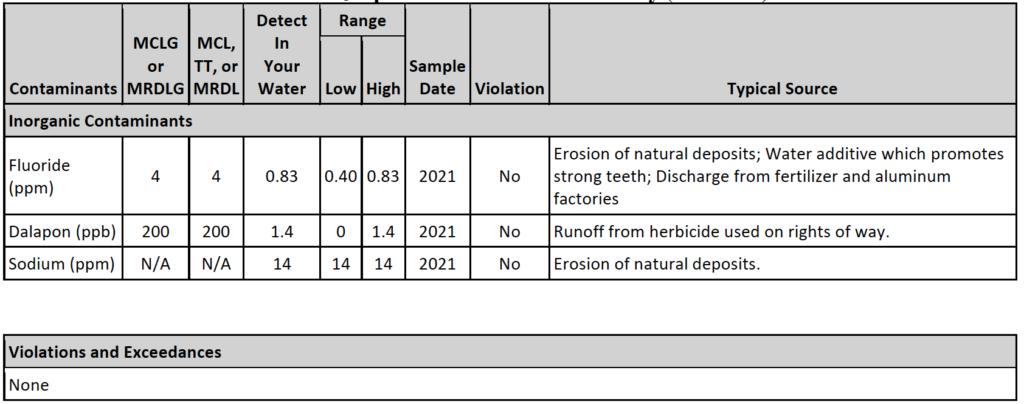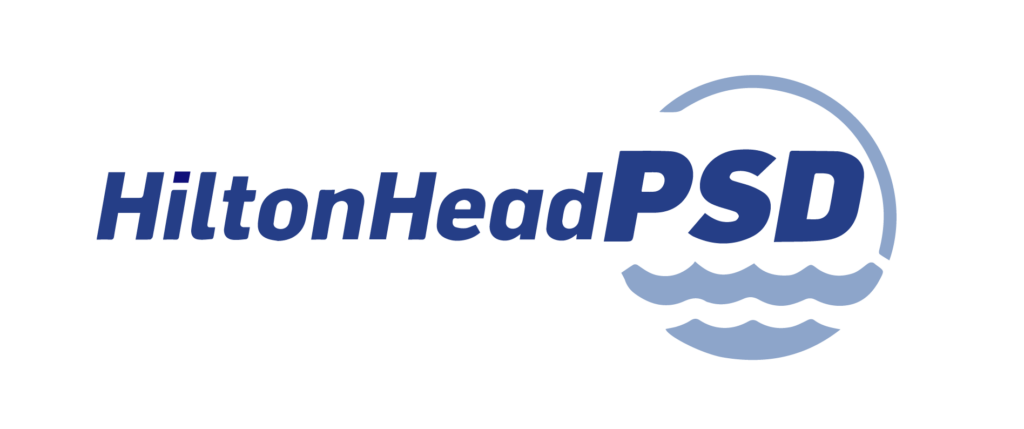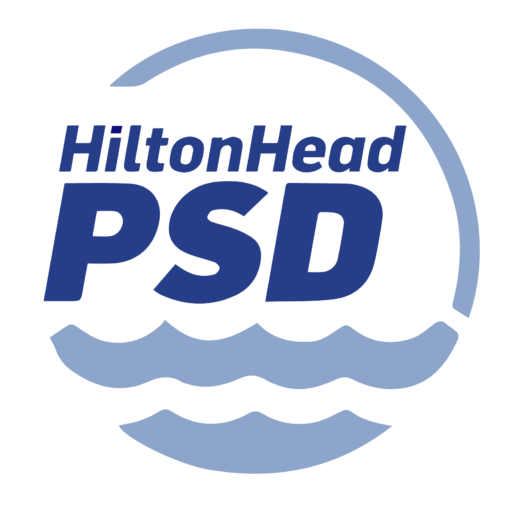This report is intended to provide you with important information about your drinking water and the efforts made by Hilton Head Public Service District (PSD) to provide safe drinking water.
Este informe contiene información muy importante sobre el agua que usted bebe. Tradúzcalo ó hable con alguien que lo entienda bien.
Hilton Head PSD is governed by an elected Board of Commissioners. The PSD Commission typically meets on the fourth Wednesday of each month in the PSD Community Room at our Water Resource Center at 21 Oak Park Drive off Mathews Drive on Hilton Head Island.
If you have questions about this report or about the water provided to you by the PSD, please contact PSD General Manager Pete Nardi at (843) 681-0525 or [email protected].
Mandatory Statements
The following mandatory statements are required by the U.S. Environmental Protection Agency (EPA) and the S.C. Department of Health and Environmental Control (DHEC) to appear in this Annual Water Quality Report, regardless of the results of water quality monitoring. These statements must appear in all Annual Water Quality Reports for all publicly regulated drinking water providers in the United States.
Source of Drinking Water
In general, sources of drinking water (both tap water and bottled water) include rivers, lakes, streams, ponds, reservoirs, springs, and wells. As water travels over the surface of the land or through the ground, it dissolves naturally-occurring minerals and, in some cases, radioactive material, and can pick up substances resulting from the presence of animals or from human activity.
The Hilton Head PSD obtains its drinking water from six (6) ground water wells into the Upper Floridan Aquifer, treated surface water from the Savannah River, and from an advanced reverse osmosis plant utilizing three (3) additional ground water wells.
A copy of the Source Water Assessment Report is available for your review at the Hilton Head PSD office or from SCDHEC. You can learn more about source water protection at www.scdhec.gov/HomeAndEnvironment/Water/SourceWaterProtection/.
Contaminants that may be present in source water include:
- Microbial contaminants, such as viruses and bacteria, which may come from sewage treatment plants, septic systems, agricultural livestock operations, and wildlife.
- Inorganic contaminants, such as salts and metals, which can be naturally-occurring or result from urban storm water runoff, industrial or domestic wastewater discharges, oil and gas production, mining, or farming.
- Pesticides and herbicides, which may come from a variety of sources such as agriculture, urban storm water runoff, and residential uses.
- Organic chemical contaminants, including synthetic and volatile organic chemicals, which are by-products of industrial processes and petroleum production, and can also come from gas stations, urban storm water runoff, and septic systems.
- Radioactive contaminants, which can be naturally occurring or be the result of oil and gas production and mining activities.
In order to ensure that tap water is safe to drink, EPA prescribes regulations which limit the amount of certain contaminants in water provided by public water systems. FDA regulations establish limits for contaminants in bottled water which must provide the same protection for public health.
Drinking water, including bottled water, may reasonably be expected to contain at least small amounts of some contaminants. The presence of contaminants does not necessarily indicate that water poses a health risk. More information about contaminants and potential health effects can be obtained by calling the EPA’s Safe Drinking Water Hotline at (800) 426-4791.
Some people may be more vulnerable to contaminants in drinking water than the general population.
Immuno-compromised persons such as persons with cancer undergoing chemotherapy, persons who have undergone organ transplants, people with HIV/AIDS or other immune system disorders, some elderly and infants can be particularly at risk from infections. These people should seek advice about drinking water from their health care providers. EPA/CDC guidelines on appropriate means to lessen the risk of infection by Cryptosporidium and other microbial contaminants are available from the Safe Drinking Water Hotline (800-426-4791).
If present, elevated levels of lead can cause serious health problems, especially for pregnant women and young children. Lead in drinking water is primarily from materials and components associated with service lines and home plumbing. We cannot control the variety of materials used in plumbing components. When your water has been sitting for several hours, you can minimize the potential for lead exposure by flushing your tap for 30 seconds to 2 minutes before using water for drinking or cooking. If you are concerned about lead in your water, you may wish to have your water tested. Information on lead in drinking water, testing methods, and steps you can take to minimize exposure is available from the Safe Drinking Water Hotline or at http://www.epa.gov/safewater/lead.
The following definitions will help you understand the data and information presented in the Water Quality Test Result tables, some of which may require explanation.
| Unit Descriptions | |
| Term | Definition |
| ppm | Parts per million, or milligrams per liter (mg/L) – one ounce in 7,350 gallons of water |
| ppb | Parts per billion, or micrograms per liter (µg/L) – one ounce in 7,350,000 gallons of water |
| % positive samples/month | Percent of samples taken monthly that were positive |
| NA | Not applicable |
| ND | Not detected |
| NR | Monitoring not required, but recommended. |
| positive samples | The number of positive samples taken that year |
| Important Drinking Water Definitions | |
| Term | Definition |
| MCLG | Maximum Contaminant Level Goal: The level of a contaminant in drinking water below which there is no known or expected risk to health. MCLGs allow for a margin of safety. |
| MCL | Maximum Contaminant Level: The highest level of a contaminant that is allowed in drinking water. MCLs are set as close to the MCLGs as feasible using the best available treatment technology. |
| TT | Treatment Technique: A required process intended to reduce the level of a contaminant in drinking water. |
| AL | Action Level: The concentration of a contaminant which, if exceeded, triggers treatment or other requirements which a water system must follow. |
| Variances and Exemptions | State or EPA permission not to meet an MCL or a treatment technique under certain conditions. |
| MRDLG | Maximum Residual Disinfection Level Goal. The level of a drinking water disinfectant below which there is no known or expected risk to health. MRDLGs do not reflect the benefits of the use of disinfectants to control microbial contaminants. |
| MRDL | Maximum Residual Disinfectant Level. The highest level of a disinfectant allowed in drinking water. There is convincing evidence that addition of a disinfectant is necessary for control of microbial contaminants. |
| MNR | Monitored Not Regulated |
| MPL | State Assigned Maximum Permissible Level |
| LRAA | Locational Running Annual Average. The average of analytical results for samples at a particular monitoring location during the previous four calendar quarters. |
Water Quality Data Table
In order to ensure that tap water is safe to drink, EPA prescribes regulations which limit the amount of contaminants in water provided by public water systems. The table below lists all of the drinking water contaminants that we detected during the calendar year of this report. Although many more contaminants were tested, only those substances listed below were found in your water.
2021 Regulated Contaminants Detected
Hilton Head PSD (#0720006)

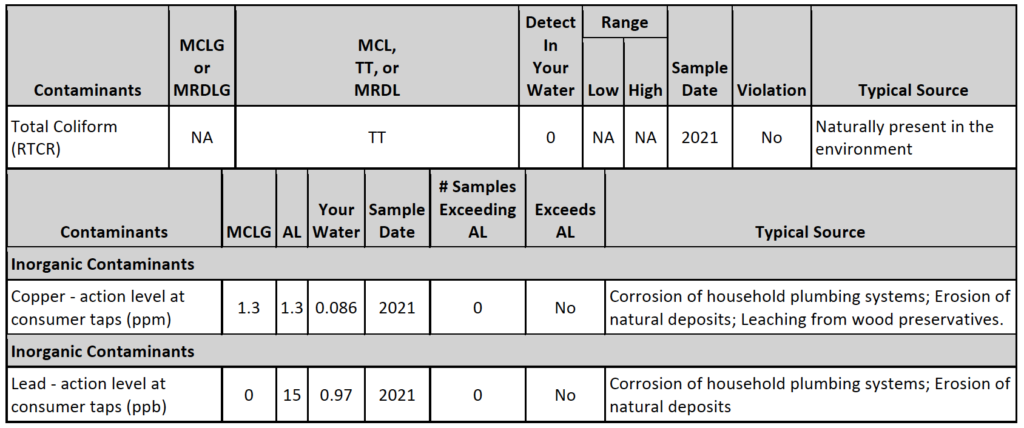
2021 Regulated Contaminants Detected
Beaufort-Jasper Water & Sewer Authority (#0720003)
